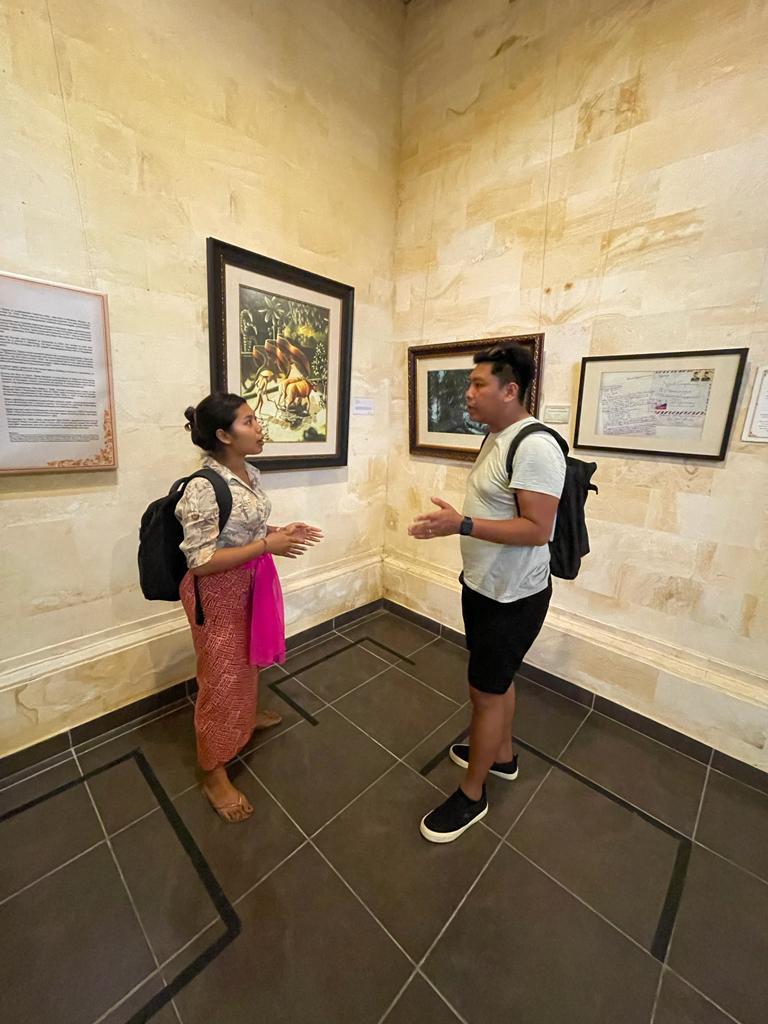There is no other way to get to know history by walking down to the city and the street to explore the culture and its’s history. If you are stay in Ubud Area we will recommend you to do the Ubud Tour by Ubud Story Walks. They are specialising in a unique, guided tour around Ubud focused on discovering different histories of the town on foot.cover the history and cultural heritage of Ubud, from the emergence of Hinduism, all the way to the modern day. This walk is an introduction to the history of Ubud and is perfect for first-timers in Bali. They reveal how the Balinese navigated the last 100 years, and how they’ve tapped into their culture to become a hub for traditional and contemporary spiritual practices.
You will visit 6 Point of Interests in Ubud, starting from Pura Gunung Lebah, one of Ubud’s main historical landmarks: an 8th-century temple enclosed by the scenic jungle surroundings, standing above the Campuhan River. Though visitors aren’t allowed to enter past the temple gates, you can see the beautiful structure of ancient Balinese architecture. This temple was built by Rsi Markandaya, a holy priest from India who is regarded as one of the most important religious figures in Balinese Hinduism. Then, down to the banks of the river, where shrine was built with a statue of the holy priest on the site of his most beloved place of meditation, the point of confluence of two rivers, to the left Wos Kiwa and to the right Wos Tengen, which converge into a single stream.




And the second Point is Old Campuhan Bridge, where we stood in-front of one of Ubud’s long-standing restaurants, Murni’s Warung, a real institution. This bridge was built by the Dutch Colonial era on the town, referencing the old Campuhan Bridge (found beside the current bridge), a remnant of their time in Bali. Due to its aged and worn-down state, flower pots have been placed on either end of the bridge to halt visitors from walking across the frail bridge for safety concerns.




Next for the third Point we continued uphill towards the centre of town, taking in Ubud’s surroundings as we strolled onwards, and go inside to Museum Puri Lukisan. Palace of Paintings, is the oldest museum in Ubud. Its history is closely linked to the friendship between Tjokorda Gde Agung Sukawati, the prince of Ubud, and the Dutch artist, Rudolf Bonnet, who both shared a common goal of preserving Balinese paintings and inspiring future generations. Utilizing land gifted by Agung Sukawati, Bonnet designed a building encompassed by a garden to exhibit their personal collections, including artworks by Pita Maha Association members such as I Gusti Nyoman Lempad and A.A. Sobrat. The north building was completed in 1956 and is the Museum Puri Lukisan’s oldest structure, marking a significant milestone in Agung Sukawati’s and Rudolf Bonnet’s joint vision.




The next destination was Pura Taman Saraswati. This unique temple features a path at the centre with various sculptures along the pathway, enclosed by a vast pond adorned with beautiful pink lotus flowers and a water garden. This photogenic spot is a favourite for just that reason: photos! This temple was designed by I Gusti Nyoman Lempad – a Balinese ‘undagi’, or architect and sculptor – in 1952, as a place of worship for the Hindu Goddess of Knowledge, Dewi Saraswati. He explained the philosophy of the design, an homage to the fantastic mythology of Bali and also Hinduism.


Next up was Puri Saren or the Ubud Palace, the residence of the Ubud royal family. As always, the palace was busy with tourists, all snapping their photos. The Ubud Royal Palace, also known by its Indonesian name Puri Saren Agung, was an important building in the 1800s, when the top Balinese artists were flocking to Ubud to show off their skills. Don’t expect something huge and grand like Buckingham Palace. This is more of a mini palace, and you could walk through the whole thing in 15 minutes. Still, there’s a lot of great art and culture to soak up here, so take it slowly and pay attention to the details. The walls and doorways have intricate frog-like demon faces carved into the stone, and there’s a door at the back of the courtyard with some of the best designs — gold winged flowers and stone monkey carvings


Finally, we headed to one of Ubud’s lesser-visited sites: the Lempad House, the humble abode of the aforementioned undagi, I Gusti Nyoman Lempad. Although the Lempad House is mere minutes away from the Ubud Palace, many visitors overlook or simply miss the Lempad House, which is open to visitors. It features the eclectic collection of Bali’s great artist, some unfinished sculptures and artwork which have some stories to share!

Ubud Story Walks is a fantastic concept that helps promote slow tourism, where visitors can actually take a minute to learn and appreciate the island’s unique culture and history, instead of visiting a famous place just to take pictures for their social media without having any context of its background.
If you interested to join this tour it will cost at IDR 350,000 per person, which includes all guide fees and entrance tickets for a maximum group of 6 people. The tour normally starts at 8.30am and lasts approximately 2,5 hours. The tour is recommended for adults and children above 14 years old.
It should be noted that this tour recommends participants wear comfortable footwear and attire suitable for long-distance walking, preferably anti-slip footwear as several paths can be quite slippery. An umbrella might come in handy at some point as the weather in Ubud can prove to be quite unpredictable, with the possibility of rain.
